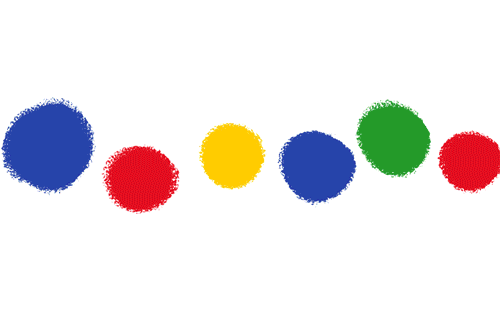
Google has replaced their homepage logo with artwork in the style of Georges Seurat, the French painter who created Pointillism.
Life of Georges Seurat
Georges Pierre Seurat was born on December 2, 1859 in Paris, France to a wealthy family. In his teen years, Seurat studied fine art at Parisian schools like the École des Beaux-Arts, where he learned of color theory and contrasts. In 1879, he left art school behind to serve the military.
After a year with the military, Georges Seurat returned to Paris, where he resumed his pursuit of art, with special attention to the craft of monochromatic (single-colored) works. One of his works of this period, a crayon portrait of his roommate, was featured in 1883 at the Salon in Paris, a prestigious venue for new artwork.
That same year, Seurat labored on a more crucial work, “Bathers at Asnières,” which combined the physical painting style of Impressionism, but leaned more on the style of classic works by having clearly distinguished shapes and figures. While “Bathers at Asnières” was not accepted by the Salon, a suitable venue was ultimately found.
In 1884, Georges Seurat and other independent artists joined to form Société des Artistes Indépendants. This coalition offered a venue to artists like Seurat who were breaking from the past styles, as well as help teach new styles to other artists and set the trend for the next era.
Around this same time, at the age of 24, Seurat began work on what would become his signature piece. Up to this point, Seurat — just as much a man of logic and science as of art and creativity — had been following the optical discoveries of scientists like Michel Chevreul. Building on their theories, Seurat supposed that the most vivid way to mix colors would be to place dots of different colors near each other.
In his theory, rather than creating the color subtractively — combining pigments to make increasingly darker colors — light could reflect and potentially be combined additively by the eye.While the science may not necessarily bear out on making the paintings “brighter,” Seurat’s style was certainly novel. Initially termed by Seurat as “Chromoluminarism,” the technique was later referred to as “Divisionism” and finally “Pointillism.”
After three years of labor, Georges Seurat completed his masterpiece, “A Sunday Afternoon on the Island of La Grande Jatte,” and showcased it in Paris. The scene depicts Parisians enjoying a day on the banks of the River Seine. Seurat’s work inspired a generation of Pointillist artists, carrying the style forward for years to come.
Georges Seurat continued to paint and work with Société des Artistes Indépendants until he died of a sudden illness on March 29, 1891.
Georges Seurat Google Doodle

To best honor Georges Seurat, Google has created homepage Doodle that is a clear homage to Seurat’s “A Sunday Afternoon on the Island of La Grande Jatte” while demonstrating the Pointillism technique. What starts as a few sparse dots — conveniently arranged to spell “Google” — on an otherwise white canvas is steadily joined by more and more layers of points.
As each point is added, mixing with those both nearby and underneath, the scene begins to take shape. While Google’s rendition of the work is far from the intricate level of detail of the original — which features over 200,000 individual strokes on its 81.7-inch by 121.25-inch canvas painted over the course of three years — it serves as a good illustration of the intricate design work that Seurat and other pointillist artists put into their art to achieve the desired effect.
Over on the Google Doodle blog, the company has shared a few early drafts of their artwork, each with a slightly different tactic on how best to express the “Google” part of this homepage logo.

More Google Doodles:
- Google celebrates St. Andrew’s Day 2021 with latest UK Doodle
- Google Doodle pays tribute to Lotfi Zadeh, computer scientist & creator of ‘fuzzy logic’
- Google Doodle celebrates Black Creole composer Edmond Dédé on his 194th birthday
Author: Kyle Bradshaw
Source: 9TO5Google



